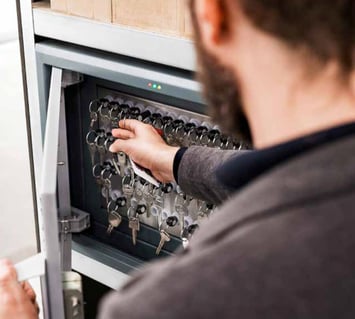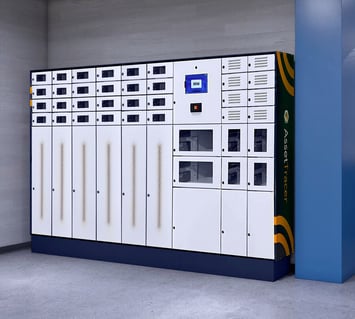By Jay Palter | June 28, 2023
Fostering employee accountability is one of the most worthwhile initiatives an organization can make. It is not just about mitigating negative problems like losses and internal theft. Improving employee accountability for how they work and what they use has far-reaching implications that can make the difference between business growth and stagnation.
Studies consistently find that supported, accountable employees tend to excel in their work, are more productive, and are actually happier. That is because building real, full accountability is not done by instituting punishments. Improving employee accountability is actually about building an environment that provides proper guidelines for everyone to understand what is expected of them and what is expected of their colleagues. It also provides the tools for everyone to carry out their jobs as effectively as possible alongside each other.
In short: accountability is really about culture. Culture building can be hard work, but it must not be complicated. Often the trick is to follow clear best practices and have the right accountability tools for the workplace available for workers and business leaders.
This article explores how employee accountability tracking is a win-win for organizations and employees, how you can conduct accountability tracking for key and equipment use in a transparent way, and details some of the most useful technologies and best practices you can use.
What are smart lockers?
This article explores how technology can play a role alongside reliable policies and training programs to improve employee accountability. One particular technology we want to highlight is smart lockers, which organizations can use to manage keys and equipment.
Conventional storage lockers are designed with a singular purpose: to ensure the security of stored equipment and keys. Obviously, that is an important task, but that is all of which they are capable.
Lockers become smart when you integrate computer monitoring systems into them. These accountability systems in the workplace can track the key and equipment use, including when workers borrow or return assets and how they utilize them.
Implementing a smart equipment management system allows these time-consuming tasks to be automated and employees to be held more accountable as all transactions are fully tracked and thoroughly logged. These accountability solutions are also highly adaptable. You can use them to implement new processes and management activities and streamline existing business operations.
Why does employee accountability matter?
Accountability is someone’s willingness to take ownership of their decisions and actions. Accountability grows from a foundation of trust. In the workplace, which means trust between coworkers, supervisors, and employees, and between the wider institution and all the people that keep it running.
Building better employee accountability will:
- Improve productivity.
- Increase morale and job satisfaction.
- Foster a culture of continuous improvement.
- And boost workforce enablement—your employees’ self-sufficiency
High levels of accountability can occur organically in particularly tight-knit teams, but it only comes with top-down initiative. But when employees see the benefits of just such an employee accountability tracking initiative for themselves and the organization, they tend to take on a self-perpetuating life of their own. For instance, managers who involve employees in policy planning and goal setting typically find that employees have a clearer understanding of their expectations, possess greater confidence in their ability to meet those expectations and perform at a higher level.
Most importantly, positive results arise when employees do not solely associate accountability with negative repercussions. When employees are unafraid of failure, receive recognition from managers for their achievements, and are supported by managers during challenging goal pursuits, they are more inclined to demonstrate creativity, innovation, and dedication in their work.
The pillars of good employee accountability tracking
Your staff accountability efforts will only be successful if you build a solid culture of accountability within your organization. That culture rests on three pillars of employee accountability tracking: technology, policies, and education.
Technology
Technology is never the focus, but it is a platform you can leverage to support better employee accountability, primarily by facilitating and improving employee interactions. For instance, technology can facilitate the sharing of keys and equipment and optimize the workflows in which they are used.
Implementing a smart locker system enables efficient management of employee key and tool transactions, ensuring that items are consistently available when needed. In case of any issues, employees can report them through the access terminal on the locker system, expediting equipment repairs. And if employees fail to return equipment on time, the locker system can notify a supervisor, enabling them to intervene and handle the situation directly.
Policies
Policies are your guard rails. They establish the boundaries of acceptable behavior and keep everyone on the same page about their roles and responsibilities. In other words: for what they are accountable.
For instance, in the context of smart locker usage, employees can be accountable for reporting any employee errors or damages to crucial electronic devices when returning them to the locker system. That can be accomplished by logging the relevant information using a digital checklist on the access panel of the locker. When all errors are recorded, there is no risk of the next user receiving a malfunctioning device. Work is more efficient for all involved.
Training
Completing the set of three pillars is training. Your employees will not know how to use your technology or apply your policies if they are not trained. You can put all the pieces in place, but you will not see any enhanced accountability if your employees do not know what to do with them.
All come together as a culture
Resting on top of the three pillars of technology, policies, and training can rest on what you are after—a full culture of accountability. Sometimes called an enabled workforce.
Let us consider a scenario where you aim to introduce a new smart locker system to manage key and asset transactions. Your workforce is skeptical. They are wondering if you do not trust them. Does employee accountability tracking mean a Big Brother-style work environment?
Implementing a training program can alleviate any concerns and help employees become more comfortable with the new system. Resistance to new technology often arises when employees perceive it as a threat to their jobs. However, you will get more complete buy-in by demonstrating how the new technological tool simplifies their tasks and enhances their job satisfaction. Over time, which can lead to a self-perpetuating positive culture of accountability.
Learn More: Everything You Need to Know About Physical Asset Tracking Systems
Best practices for employee accountability tracking
Knowing the pillars of good employee accountability tracking will only take you so far. The hard work is in applying them the right way within your organization. As we said at the outset, building a reliable culture of accountability is hard work. But it can be straightforward if you follow a few tried and true best practices.
Make performance measurable
If you want organized, systemized accountability, it is essential first to determine the metrics or behaviors that you intend to monitor. Accountability also entails addressing the consequences of subpar performance within your team. Determine what will count as ‘accountable’ within the context of your organization. And tie it to something measurable.
For example, accountable key use might involve setting key signout curfews to help ensure keys are available to all staff members. And set consequences for repeated late key returns.

Track equipment usage
Remember, the goal of establishing a culture of accountability is not to enforce punishment. It is to improve morale and efficiency. That takes constant, steady feedback. And constant feedback requires constant measurements.
Gain insights into your employees’ key and equipment utilization by tracking signout frequencies, duration, and user information. In the event of loss, having a record of the last user, time of usage, and location provides valuable information for investigation and recovery.

Track maintenance issues
Part of accountable key and equipment use is ensuring those assets are in working order for the next person in line. Your accountability tracking should allow employees to make life easier for their colleagues. Give them the resources to easily report losses, fault codes, tracking employee errors, calibration issues, and other repair needs. Automating warranty and lifecycle tracking can also inform maintenance schedules.
Smart lockers are an excellent tool for this type of tracking, and they can even facilitate maintenance workflows. For example, you can configure maintenance compartments in each locker that unlock when a user reports a problem. They deposit assets there, and the system sends an automated alert to technicians that it needs to be retrieved for servicing. The locker system does not allow other users to access it. Only an authorized technician can unlock that locker, so the device does not accidentally end up back in circulation.

Employee accountability tracking can have far-reaching benefits
Building a self-sustaining culture of accountability can be challenging, but when you can get there, the benefits are far-reaching and long-lasting. It takes technology, policy, training, and lots of hard work to get there, though.
Any organization looking to build a culture of accountability should consider what tools they need to help get them there. Smart lockers are some of the best options on the market for conducting employee accountability tracking. They are customizable for any organization's specific storage needs and workflows.

Assess Your Employees' Accountability for Keys & Assets
Determine whether improving your employees’ accountability for keys or physical assets could save you labour and equipment costs.
Subscribe to our blog

Jay Palter
Vice President of Marketing & Partnerships




